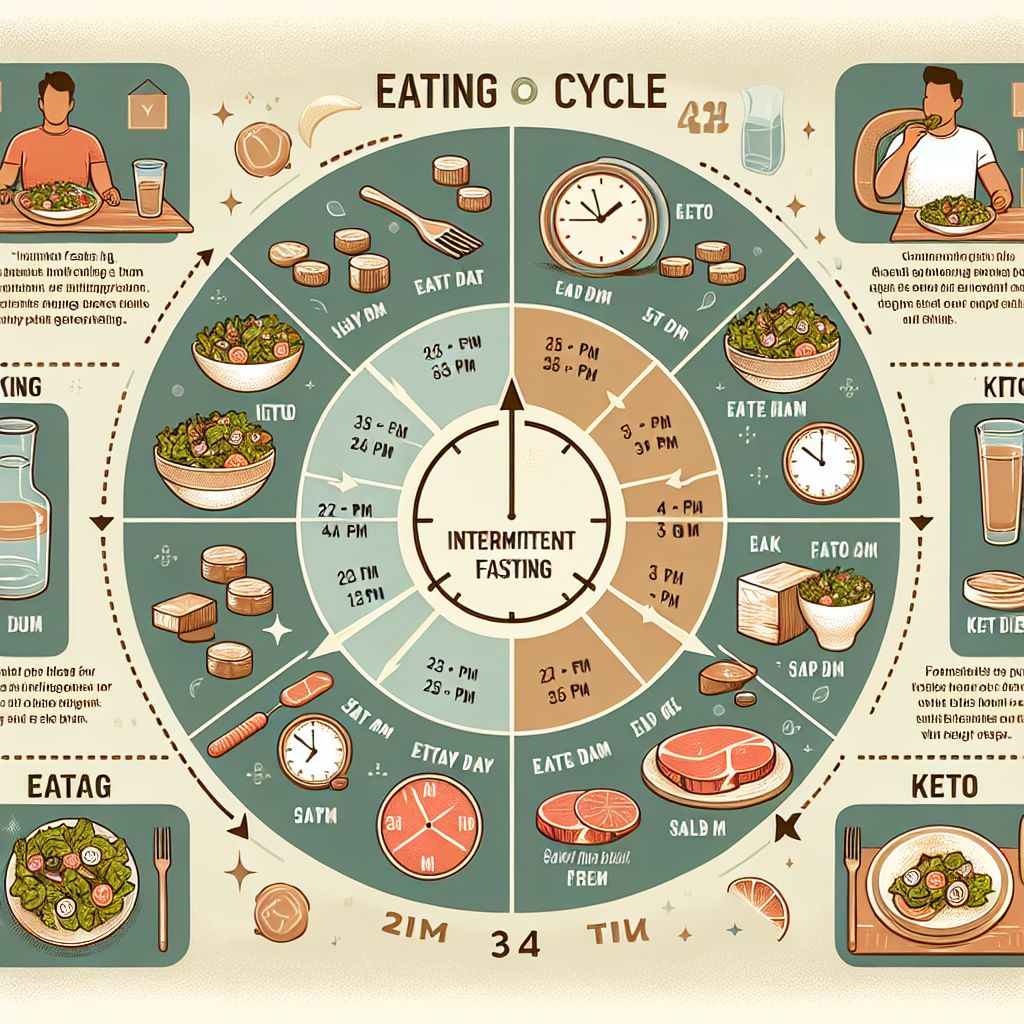
Intermittent Fasting with Keto Cycle: Maximizing Your Results
Key Takeaways
-
Intermittent fasting and keto work together to enhance fat loss and improve metabolic health.
-
Choosing the right intermittent fasting schedule and setting up your keto macros are crucial first steps.
-
Staying hydrated and managing electrolytes are key to overcoming common challenges.
-
Tracking progress helps to adjust your plan for better results.
-
The KetoCycle app can help you stay on track with meal planning, tracking, and community support.
What is Intermittent Fasting?
Imagine giving your body a break from eating, like a mini-vacation for your digestive system. That’s what intermittent fasting is all about. It’s a schedule that cycles between periods of eating and not eating. But it’s not just about skipping meals; it’s a strategic approach to eating that can boost your body’s fat-burning ability.
There are several methods to choose from, like the 16/8 method, where you eat during an 8-hour window and fast for the remaining 16 hours. Or the 5:2 method, where you eat normally for 5 days a week and limit your calories to about 500-600 for the other 2 days. The key is finding a rhythm that fits your lifestyle and sticking to it.
What is the Keto Diet?
Now, picture your body as a hybrid car that can run on sugar or fat. The keto diet is like switching your fuel source to fat. By reducing your carb intake to about 50 grams a day, your body enters a state called ketosis. Here, it becomes super efficient at burning fat for energy. Plus, it turns fat into ketones in the liver, which can supply energy for the brain.
Keto focuses on high-fat, moderate-protein, and low-carb foods. Think avocados, cheese, nuts, and leafy greens. It’s not just about losing weight; it’s about reshaping your diet to prioritize healthy fats over carbs.
How They Work Together for Greater Impact
When you merge intermittent fasting with keto, it’s like a tag team for your metabolism. Fasting starts the fat-burning process, and the keto diet keeps it going. Because your body is already cutting carbs during keto, fasting doesn’t feel like such a shock to the system. It’s a smooth transition to using fat as the primary energy source.
This combo can lead to more significant weight loss, improved insulin sensitivity, and even better mental clarity. It’s like getting the best of both worlds, with each approach boosting the other’s effectiveness.
“By aligning the natural fat-burning state of ketosis with the calorie reduction of intermittent fasting, you’re setting the stage for a powerful weight loss journey.”
But remember, while the results can be impressive, this isn’t a one-size-fits-all solution. It’s important to listen to your body and adjust your plan as needed.

Starting Your Intermittent Fasting Keto Cycle
Embarking on this journey requires a bit of preparation. You wouldn’t set off on a road trip without a map, right? Similarly, you need to plan your fasting and eating schedule, figure out your macros, and prepare your meals. Let’s get you started.
Choosing Your Intermittent Fasting Schedule
First up, pick your fasting plan. Are you a breakfast lover who can’t imagine skipping your morning meal? Then maybe an early eating window is for you. Prefer a big dinner? Consider an eating window that allows for that. The key is consistency. Whatever schedule you choose, stick to it to help your body adapt.
Setting Up Your Keto Macros
Next, you’ll need to calculate your macros – that’s your carbs, proteins, and fats. A typical keto diet might look like 70% fats, 25% protein, and 5% carbs. But these numbers can vary based on your body’s needs and your goals.
To make it simple, there are plenty of macro calculators online that can help you figure out the perfect balance. Just input your stats, and voila, you’ll have a starting point for your keto journey.
Remember, these are just guidelines. It’s all about finding what works for you and tweaking as you go. And don’t forget, the quality of your macros matters just as much as the quantity. Choose whole, unprocessed foods whenever possible.
“Crafting your keto macro plan is like building the foundation of a house. Get it right, and everything else falls into place.”
Now that we’ve laid the groundwork, let’s move on to the next steps in our journey. Stay tuned for more insights on meal planning, overcoming challenges, and tracking your progress for the best possible results.
Meal Planning for Success
Once you’ve got your fasting schedule and macros down, it’s time to talk about meal planning. This is where you can get creative! Fill your plate with keto-friendly foods like fatty fish, meats, eggs, and lots of low-carb veggies. Plan your meals around your fasting schedule to make sure you’re getting all the nutrients you need within your eating window.
Meal prep can be a lifesaver here. Cook in bulk and portion out your meals for the week. This not only saves time but also helps you avoid the temptation to grab something quick and possibly non-keto when you’re hungry.
And let’s not forget about snacks. Keep keto-friendly options on hand for those moments when you need a little something to tide you over. Think cheese slices, nuts, or a hard-boiled egg. They’re perfect for fitting into your macros without breaking your fast prematurely.
“A well-thought-out meal plan aligns with your fasting schedule and takes the guesswork out of what to eat, making it easier to stick to your goals.”
Meal planning is like putting together a puzzle – make sure all the pieces fit to complete the beautiful picture of your dietary goals.

“Intermittent Fasting On Keto: Guide For …” from www.wholesomeyum.com and used with no modifications.
“Keto Diet and Intermittent Fasting …” from www.amazon.com and used with no modifications.
Benefits of Combining Keto with Intermittent Fasting
Now, let’s dive into the good stuff – the benefits. Combining keto with intermittent fasting can lead to some pretty impressive results. Most importantly, it can ramp up weight loss. By limiting your eating window and reducing carbs, you’re giving your body the one-two punch it needs to start burning through fat stores.
Enhanced Fat Loss and Muscle Preservation
One of the biggest perks of keto intermittent fasting is the potential for enhanced fat loss while preserving muscle mass. This is because, in ketosis, your body is fueled by fat, and intermittent fasting can increase growth hormone levels, which helps protect your muscles.
And let’s not forget about the impact on your metabolism. This dynamic duo can give your metabolic rate a boost, making your body more efficient at burning calories even when you’re at rest.
Improved Metabolic Health and Energy Levels
But it’s not just about weight loss. This combination can also improve your metabolic health by reducing insulin resistance, which is great news for your energy levels and overall well-being.
Many people report feeling more energetic and less sluggish when they cut out carbs and add fasting into their routine. It’s like flipping a switch in your body, turning you into an energy powerhouse.
Mental Clarity and Focus
Ever feel foggy after a carb-heavy meal? That’s your brain on sugar. But with keto and intermittent fasting, you might just find that your mental clarity and focus improve. That’s because your brain can use ketones for fuel, which is a more efficient energy source than glucose.
So, not only are you potentially shedding pounds, but you’re also giving your brain the premium fuel it needs to perform at its best.
Common Challenges and How to Overcome Them
Of course, any lifestyle change comes with its challenges, and keto intermittent fasting is no exception. But don’t worry, I’ve got some tips to help you overcome them.
Dealing with Hunger and Cravings
When you first start fasting, you might feel hungrier than usual. That’s normal. Your body is used to running on a constant supply of carbs, and it can take some time to adjust to burning fat instead. But here’s the thing: most cravings are temporary. They usually pass after about 15-20 minutes. So, when a craving hits, try distracting yourself with a walk or a glass of water.
Also, make sure you’re eating enough during your meals. Fill up on healthy fats and proteins to keep you satiated longer. And remember, consistency is key. The more you stick to your schedule, the easier it gets.
Managing Social Events and Dining Out
Social events can be tricky when you’re fasting or sticking to a keto diet. But with a little planning, you can navigate them like a pro. If you know you have an event coming up, adjust your eating window accordingly. And when dining out, don’t be afraid to customize your order to fit your dietary needs.
Most restaurants are accommodating if you ask for substitutions like extra veggies instead of fries or a bun-less burger. And if you’re at a party, focus on the people and the conversation more than the food. You’re there for the company, after all!
Staying Hydrated and Managing Electrolytes
Hydration is crucial, especially when you’re fasting. Water helps keep hunger at bay and ensures your body functions optimally. Aim for at least 8 glasses a day, and don’t forget to replenish your electrolytes. When you cut carbs, your body sheds water and electrolytes with it.
Add a pinch of salt to your water or sip on bone broth to keep your electrolyte levels in check. It’s a simple step that can make a big difference in how you feel.
Now that we’ve tackled the common challenges, let’s look at how to track your progress and adjust your plan to keep those results coming.
Tracking your progress is more than watching numbers on a scale; it’s about understanding how your body responds to changes and making adjustments for optimal health. Keep a journal or use an app to record what you eat, your fasting windows, and how you feel. This way, you can pinpoint what works best for you and what doesn’t.
Monitoring Weight and Body Composition
Weight can fluctuate daily due to a variety of factors, so don’t get discouraged by the normal ups and downs. Instead, focus on the overall trend over weeks and months. Body composition, meaning the ratio of fat to muscle, is also key. Sometimes you may not see a big change in weight, but you’ll notice your clothes fit differently as your body composition improves.
Adjusting Your Diet and Fasting Schedule
If you hit a plateau or aren’t seeing the results you expected, it might be time to tweak your plan. Maybe you need to shorten your eating window or adjust your macros. Perhaps you’re not eating enough calories, or maybe you’re eating too many. Small adjustments can lead to big results, so don’t be afraid to experiment.
Using Technology to Stay on Track
Technology can be a powerful ally in your weight loss journey. Use apps to track your meals, fasting times, and workouts. They can help you stay accountable and provide valuable insights into your habits.

“Healthy weight loss- It’s not a diet …” from www.theshapewithin.com and used with no modifications.
Maintaining Your Intermittent Fasting Keto Lifestyle Long-Term
Adopting an intermittent fasting keto lifestyle is a commitment to your health. To make it sustainable, you need to find your groove and stick with it. This means setting realistic goals, finding enjoyable keto-friendly foods, and building habits that align with your lifestyle.
Staying Motivated and Setting New Goals
Stay motivated by setting short-term and long-term goals. Celebrate your successes, no matter how small. And when you achieve a goal, set a new one to keep pushing forward. Whether it’s trying a new keto recipe each week or aiming for a new personal best in your workouts, having something to strive for can keep you motivated.
Incorporating Regular Physical Activity
Exercise is a fantastic complement to your Keto Guide to Intermittent Fasting. Not only does it help you burn more calories, but it also boosts your mood and energy levels. Find activities you enjoy, whether it’s lifting weights, yoga, or just taking a brisk walk. The key is to move your body regularly.
Building a Support System
Surround yourself with people who support your goals. Join online communities, find a keto buddy, or get your family on board. Having a support system can make a world of difference when it comes to staying on track and overcoming obstacles.
Tools and Resources to Enhance Your Journey
There are numerous tools and resources available to help you on your intermittent fasting keto journey. From apps to books, you have a wealth of information at your fingertips.
KetoCycle App: A User-Friendly Guide for Your Diet
The KetoCycle app is a fantastic resource for anyone on a keto diet. It offers personalized meal plans, tracks your macros, and even provides grocery lists to simplify your shopping. Plus, it’s backed by a study that showed users experienced significant weight loss, making it a credible tool to enhance your diet.
The Role of Community in Keto and Intermittent Fasting Success
Community plays a significant role in the success of any diet plan. Sharing experiences, asking questions, and getting support from others who are on the same journey can be incredibly motivating. Online forums, social media groups, and local meetups are great places to connect with like-minded individuals.
Explore our comprehensive Personalized Keto Diet Meal Plans to expand your knowledge.
Knowledge is power, especially when it comes to diet and health. Arm yourself with books and cookbooks that delve into the science of keto and intermittent fasting. They can provide new recipes, tips, and the motivation to keep going.
FAQs
Got questions? You’re not alone. Here are some frequently asked questions about combining intermittent fasting with a keto diet.
Can Intermittent Fasting and Keto be customized to my needs?
Absolutely! Both intermittent fasting and keto are flexible. You can adjust your eating window, macros, and food choices to fit your lifestyle, preferences, and goals. It’s all about finding what works for you and making it a sustainable part of your life.
How long does it typically take to see results from Intermittent Fasting with Keto?
Results can vary, but many people start to see changes within a few weeks. It’s important to give your body time to adjust and to be consistent with your diet and fasting schedule.
What if I experience low energy levels while on this program?
It’s normal to feel a bit sluggish as your body transitions from burning carbs to fat. Make sure you’re eating enough calories during your eating window and staying hydrated. If low energy persists, consider adjusting your macros or consulting with a healthcare professional.
“Listen to your body and be willing to make changes. Your journey is unique, and what works for one person may not work for another.”
Are there any risks associated with using Intermittent Fasting and Keto together?
As with any diet, there are potential risks, especially if you have underlying health conditions. It’s always a good idea to consult with a healthcare professional before starting a new diet, especially one that involves significant changes to your eating habits.
How can I ensure I stay healthy while following this diet plan?
Eat a variety of nutrient-dense foods, stay hydrated, manage your electrolytes, and listen to your body. Regular check-ups with your healthcare provider can also help ensure you’re on the right track.

Hi, I’m David, the founder of Semaglutide Group and a passionate advocate for busy moms looking to reclaim their health and well-being. I understand the challenges that come with balancing family responsibilities while trying to maintain a healthy lifestyle. My knowledge of semaglutide has been impactful, and now I’m on a mission to share this knowledge with other moms who are eager to find a sustainable path to weight loss.
1 thought on “Intermittent Fasting with Keto Cycle: Maximizing Your Results”
Leave a Reply
You must be logged in to post a comment.

[…] up, we’ll discuss how to incorporate grass-fed beef protein into your diet effortlessly and the benefits it has on sustainable nutrition. Keep reading for […]